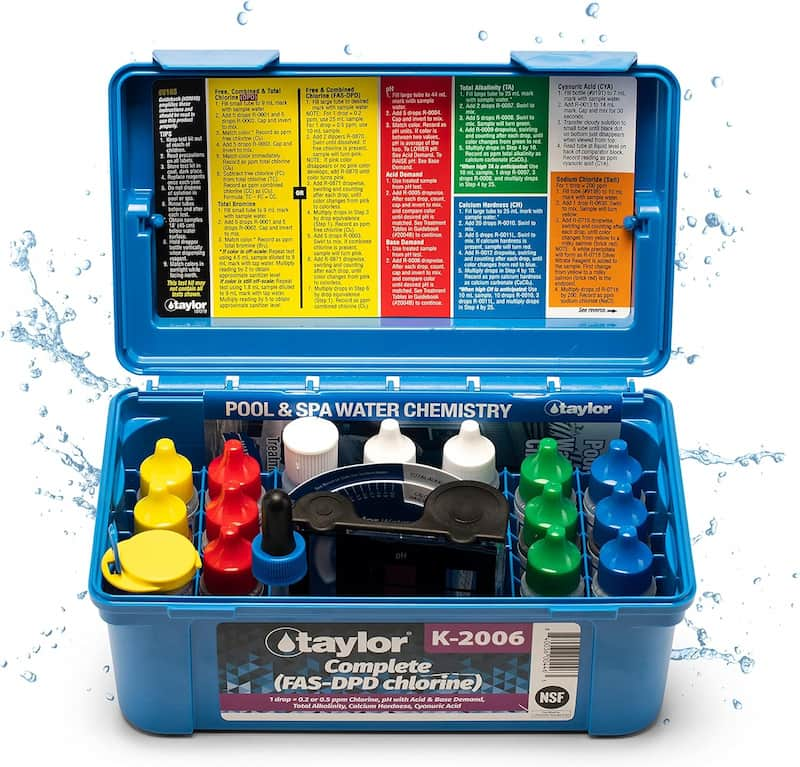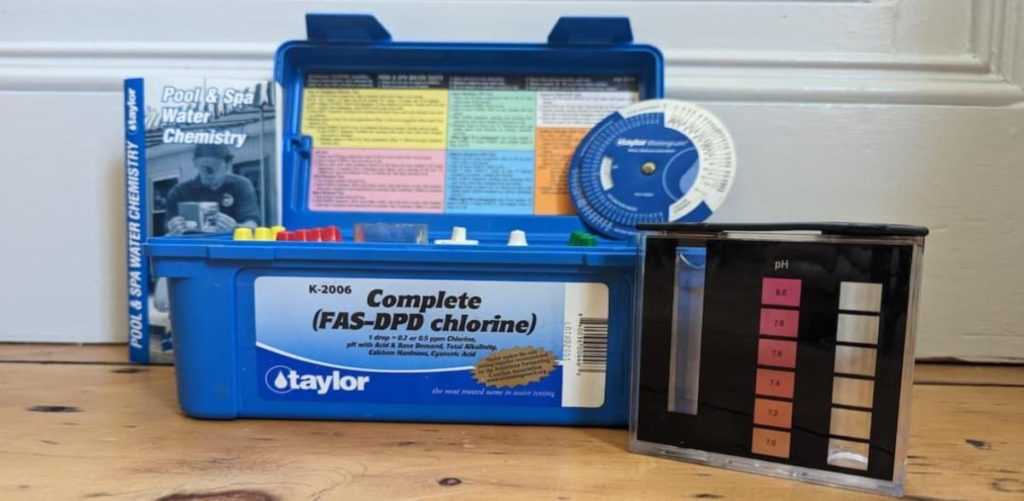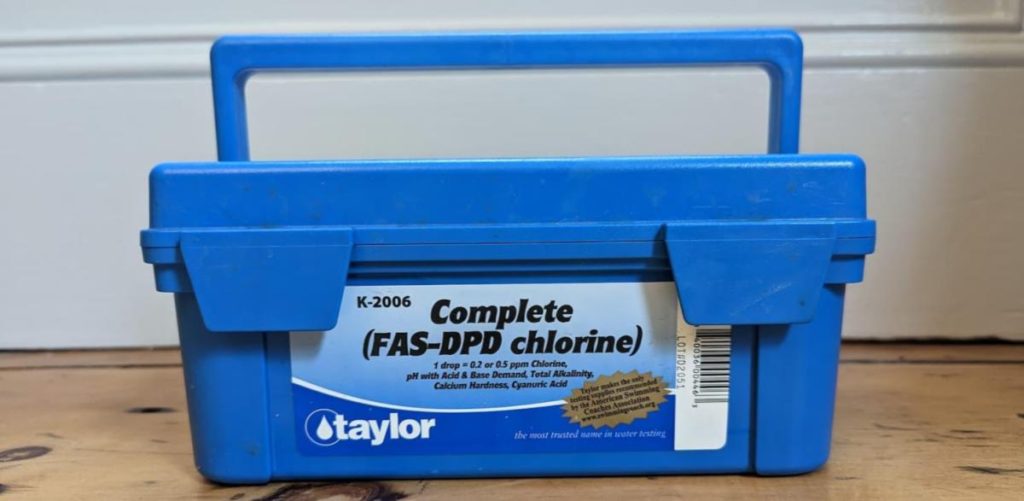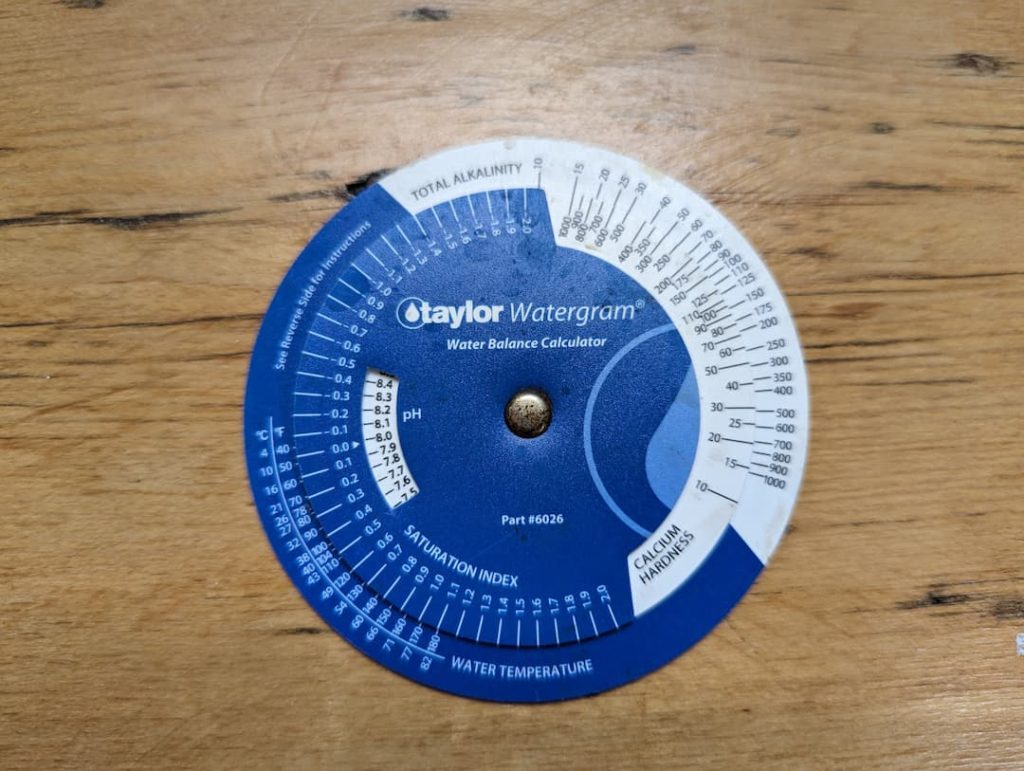A pool testing kit needs to be accurate, reliable, and able to test all of the necessary parameters for a perfectly balanced pool.
No other kit meets all of the above criteria besides the Taylor K-2006 from Taylor Technologies. It is by far the most accurate kit on the market.

Taylor K-2006
The most accurate and reliable testing kit available. This is a must-have for any pool owner who maintains their pool.
Pros
Cons
Taylor K-2006 Specs
Dimensions LxWxH: 9.5 x 6 x 4 inches
Weight: 2.31 pounds
Included Tests: Free Chlorine, Combined Chlorine, Bromine, pH (including acid and base demands), Total Alkalinity, Calcium Hardness, CYA
Saltwater Tests: Included in K-2006-SALT
Chlorine Test Type: FAS-DPD
Reagent Bottle Size: 0.75 oz (K-2006C comes with 2 oz bottles)
Price: From $80
*As an Amazon Associate, I earn from qualifying purchases at no additional cost to you.
Taylor K-2006 Overview
The Taylor K-2006 kit is a comprehensive and complete testing solution for pool owners and service professionals.

The kit is known for its accuracy and the range of tests it can perform, providing a deep understanding of your pool’s chemistry. It will measure the water’s free chlorine (FC), combined chlorine (CC), pH, total alkalinity (TA), calcium hardness (CH), and bromine if that’s used instead of chlorine.
The kit itself comes in four different models:
- K-2006
- K-2006C – Same as K-2006 but with 2 oz reagent bottles
- K-2006-SALT – Includes sodium chloride test
- K-2006C-SALT – Same as K-2006-SALT but with 2 oz reagent bottles
One of the key features of this kit is the ability to measure FC and CC using the FAS-DPD titration method, which is notably more precise than the DPD and OTO methods used in many other kits. This gives the ability to directly test FC and CC independently from one another, which can measure as low as 0.2 ppm and as high as 20 ppm.
FAS-DPD eliminates the need for traditional color matching. Instead, the change is from a distinct pink to no color. This benefits users with difficulty distinguishing between close color gradients and those with color vision problems.
Here is a video showing the FAS-DPD method using the K-2006 kit.
K-2006 Kit Unboxing
The K-2006 comes with everything necessary to test the pool, including all of the reagents and testing tubes for each parameter.
The reagents for the standard kit are 0.75 oz. The more heavily used tests, specifically free chlorine, barely make it through a swim season. I need a refill to start each year and have also had to replenish through the middle a few times.
The kit itself comes in a nice and convenient carrying case that can hold all reagents and testing tubes. It’s not too bulky and it’s tight enough inside that the reagents and tubes don’t move too much.

After four years of pretty heavy use and almost daily carrying out to the pool, the case doesn’t show any signs of breaking or wearing down.
The kit also includes a pretty handy instruction manual and guide. It includes overviews of testing instructions, diagnosing water issues like algae and cloudy water, and tables showing how much pool chemicals to add to increase or decrease each parameter based on the volume of water (in gallons and liters).
Whether you are a new pool owner or a professional, I highly recommend reading this front-to-back.
Lastly, the kit comes with what Taylor calls a Watergram Water Balance Calculator. Essentially, it is a quick and easy way to measure the water’s saturation index, whether it is balanced or not.
It’s a nice little tool that takes seconds to use.

Price and Availability
The K-2006 is widely available through many online retailers and can also be bought in pool and big box stores across the United States.
Prices will vary depending on the time of year and inventory per store or retailer. The typical range for the standard K-2006 kit is $80 to $130.
As of this review, Taylor’s site lists at $127.43 while Amazon has a listing price of $82.99.
The Procedure of Each Test
The tests themselves are pretty straightforward.
Free and combined chlorine use the FAS-DPD testing method so there is no color matching for chlorine, just a color change of the sample.
Total alkalinity and calcium hardness use a drop titration method. This involves adding an initial reagent indicator in the water sample and then adding another reagent drop-by-drop until the sample changes colors. This takes the guessing out of the tests.
Watch this video of a calcium hardness test to see the color change. Note: I am using Taylor’s SpeedStir to speed up testing.
pH is tested with a color-matching test, which can be pretty frustrating at times due to the color gradients closely matching at each level.
It can take some time to get the best reading. Fortunately, the pH test comes with an acid test and a base test reagent to give you a better understanding of what is needed to reach your targeted level.
Lastly, the CYA test is more or less a dot-disappearing test. It involves looking at a dot in the comparator tube and filling it up until it disappears. Taylor has a good visualization of this:

Performance of the K-2006 Kit
Taylor designed the K-2006 as a complete one-stop shop for pool testing and maintenance. I’ve tested numerous kits, and nothing really came close in terms of accuracy and reliability.
Accuracy of the K-2006 Kit
As stated numerous times already, the accuracy for each test of the K-2006 is unmatched compared to other kits.
I have done numerous tests back-to-back, even three or four times in a row. Each time, when using the same methods, the results stayed the same!
This gives me peace of mind that the numbers I am recording is what is actually in the water
K-2006 Reliability
The reliability of this kit starts and ends with accuracy. For over four swim seasons of using this kit as my primary testing method, I have yet to encounter any water issues or algae blooms.
That is largely due to the fact that the results I get for each test are an accurate portrayal of my pool.
Ease of Use
The biggest drawback is the ease, or lack thereof, use of this kit. There definitely is a steeper learning curve than other tests. Looking at the directions pasted on the lid of the carrying case for the first time can definitely look intimidating.
It definitely isn’t as plug-and-play as other kits and test strips are. It takes a few weeks of continuous use to finally be able to understand the drop count of each reagent.
The directions of the tests are one thing, but in order for the tests to be as accurate as possible, you need to follow some guidelines to make sure each test is as accurate as possible. For example, I’ll list a couple:
- Using the correct sample volume for each test. If a test asks for a 10mL sample size and you pour 11mL, the test may be inaccurate.
- Each drop size should be equal throughout each test. A larger drop adds more reagent which can make the test less accurate. This can be cumbersome for a calcium hardness test where 30-40 drops per test is pretty normal.
All of this is in the instruction manual provided, which is another reason why it should be read!
Duration of Testing
This may come as no surprise, but the K-2006 easily takes the “longest” to fully complete each test. Personally, it will take me about five to seven minutes to accurately go through each test, which compared to a ten-second test strip seems a bit lop-sided.
However, I will gladly make that tradeoff for the accuracy and reliability of the test alone.
Additionally, Taylor may understand the dop-test method may take a bit longer, so they sell a magnetic stirrer called the Speedstir. I use one and it cuts the testing time drastically. It lets me focus more on the drops themselves instead of doing the drop, swirl, count
Verdict: The Only Testing Kit You Need is the K-2006
It’s pretty simple, this kit is a must-have for every pool owner. The concerns about the kit and testing procedures pretty much go away after a couple of weeks of testing.
There are just some things where it isn’t worth it to not get the best. Your pool is one of those things. A couple of extra minutes can save you from days and weeks of cleaning up a water issue.
It’s a no-brainer to use this as your primary testing kit
Why Trust This Review?
With over 10 years of pool ownership, I’ve gone through many testing kits and strips to find which works best for me.
I have been using the Taylor K-2006 as my primary testing kit for over 4 years as of this review. All images, videos, and input are my own without any outside influence.
